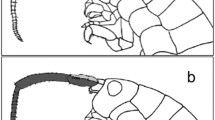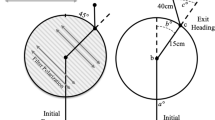Summary
-
1.
The Linyphiid spider Frontinella communis changes its orientation from random with respect to the sun (Fig. 1A) to aligned with the rays of the sun (Fig. 1B) on days when both insolation and ambient temperature are high (Fig. 2). The orientation is not mediated by visual photoreception. Because the orientation behavior is not elicited when insolation is high and ambient temperature is low, an antipredator or antiprey behavioral role is rejected and a thermoregulatory function proposed.
-
2.
Body temperature measurements of a spider at different orientations to the sun reveal that alignment of the spider's oral-anal axis with the sun's rays results in at least a 0.5°C decrease in TB relative to TB when the spider's axis is perpendicular to the sun.
-
3.
F. communis has a LT50 of 41.8°C, a temperature that the spider probably never approaches over much of its geographic range. Therefore, it is unlikely that the orientation behavior functions to keep the spider within a nonlethal temperature range. Instead, the behavior probably functions in depressing this poikilotherm's metabolic rate over a broad temperature range, and thus permits reallocation of nutrient resources from maintenance to reproduction.
Similar content being viewed by others
References
Batschelet E (1965) Statistical methods for the analysis of problems in animal orientation and certain biological rhythms. AIBS, Washington, DC
Carrel JE (1978) Behavioral thermoregulation during winter in an orb-weaving spider. Symp Zool Soc London 42:41–50
Krakauer T (1972) Thermal responses of the orb-weaving spider Nephila clavipes (Araneae: Argiopidae). Am Midl Nat 88:245–250
Muth A (1977) Thermoregulatory postures and orientation to the sun: a mechanistic evaluation for the zebra-tailed lizard, Callisaurus draconoides. Copeia 1977:710–720
Porter WP, Mitchell JW, Beckman WA, De Witt CB (1973) Behavioral implications of mechanistic ecology: thermal and behavioral modeling of desert ectotherms and their micro-environment. Oecologia 13:1–54
Riechert SE, Tracy CR (1975) Thermal balance and prey availability: bases for a model relating web-site characteristics to spider reproductive success. Ecology 56:265–284
Robinson MH, Robinson BC (1973) Ecology and behavior of the giant wood spider Nephila maculata (Fabricius) in New Guinea. Smithson Contrib Zool 149:1–75
Robinson MH, Robinson BC (1974) Adaptive complexity: the thermoregulatory postures of the golden-web spider Nephila clavipes, at low latitudes. Am Midl Nat 92:386–396
Turnbull AL (1973) Ecology of the true spiders (Araneomorphae). Annu Rev Entomol 18:305–348
Author information
Authors and Affiliations
Rights and permissions
About this article
Cite this article
Suter, R.B. Behavioral thermoregulation: Solar orientation in Frontinella communis (Linyphiidae), a 6-mg spider. Behav Ecol Sociobiol 8, 77–81 (1981). https://doi.org/10.1007/BF00300818
Received:
Accepted:
Issue Date:
DOI: https://doi.org/10.1007/BF00300818




